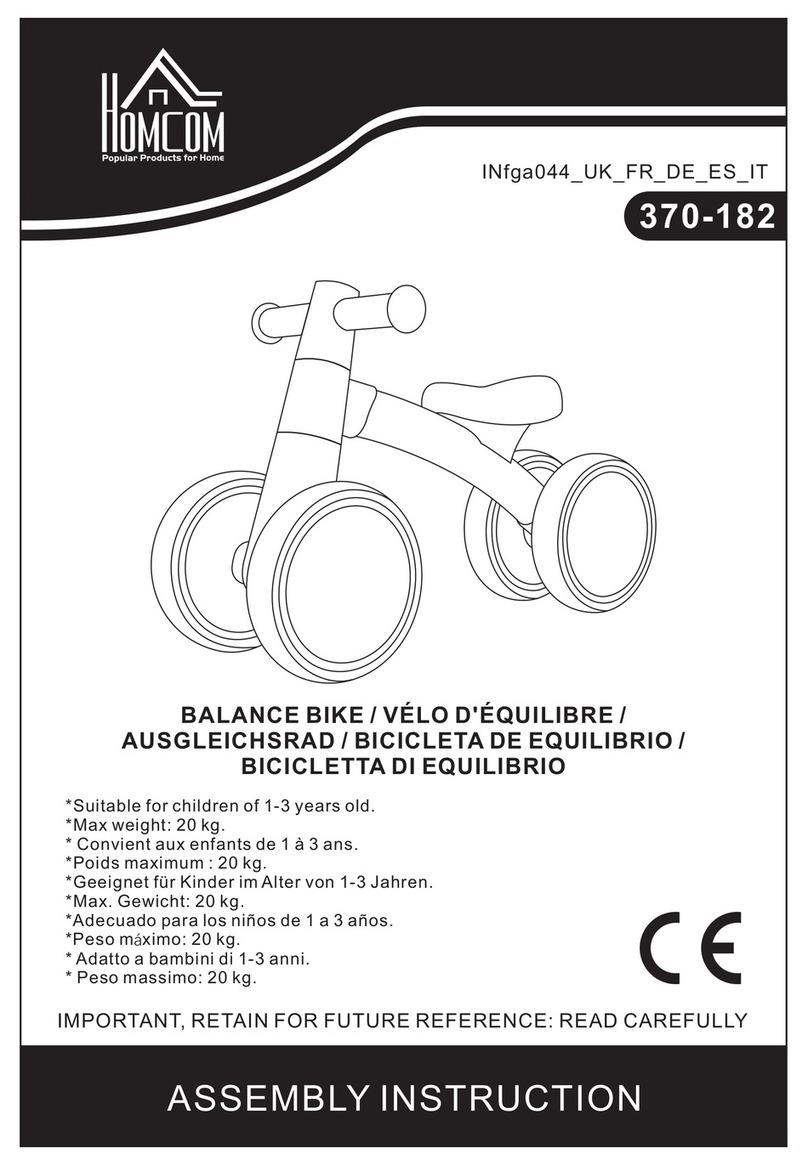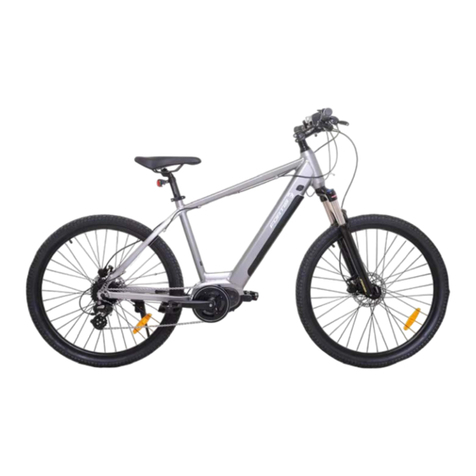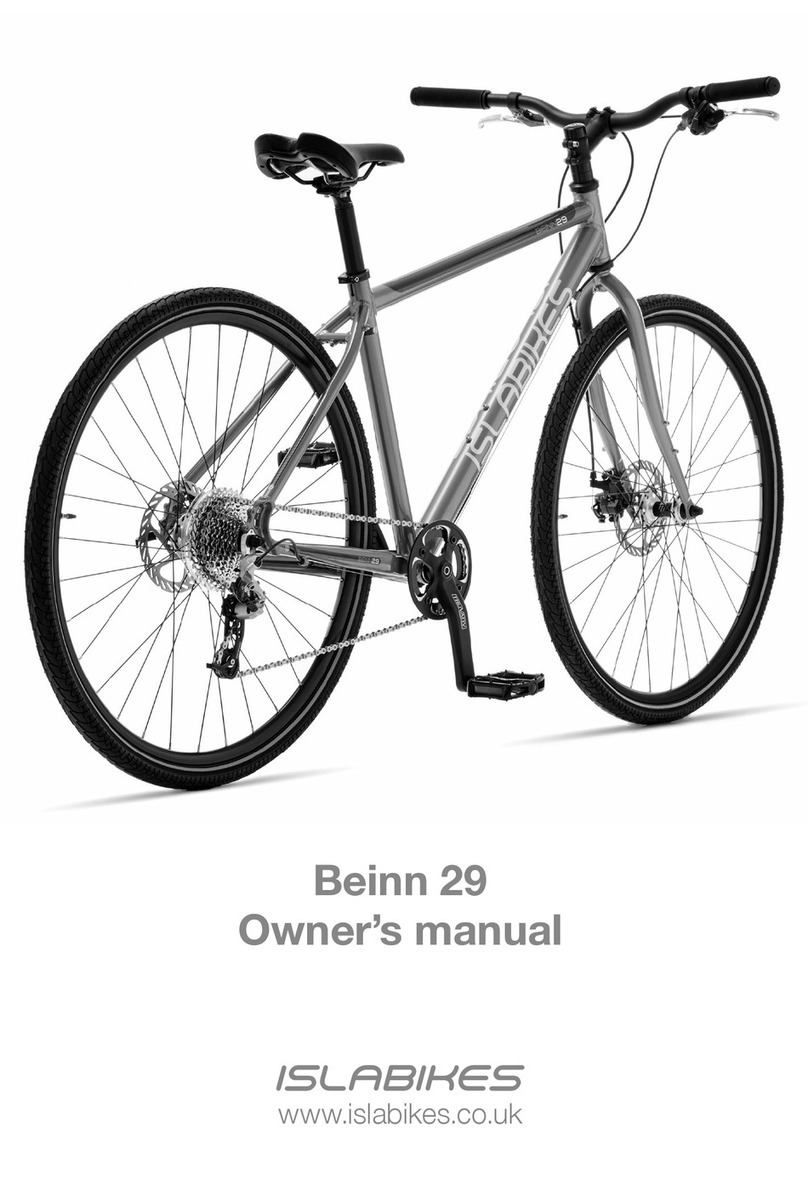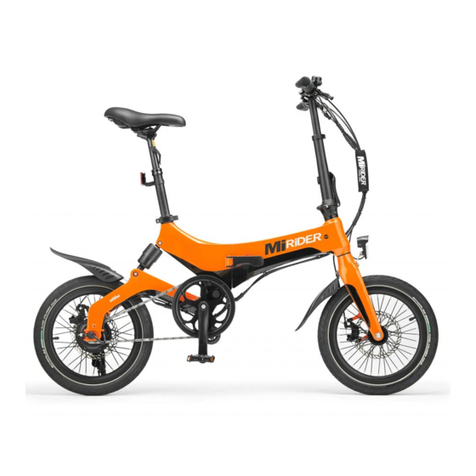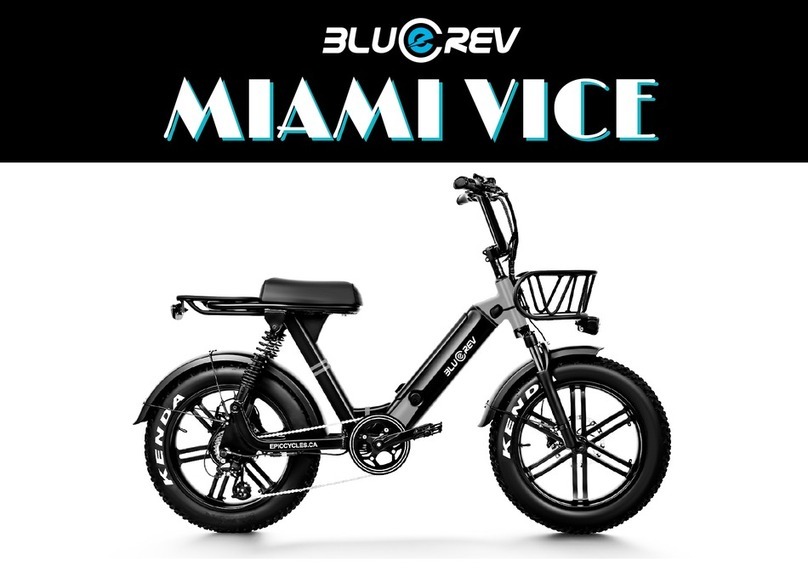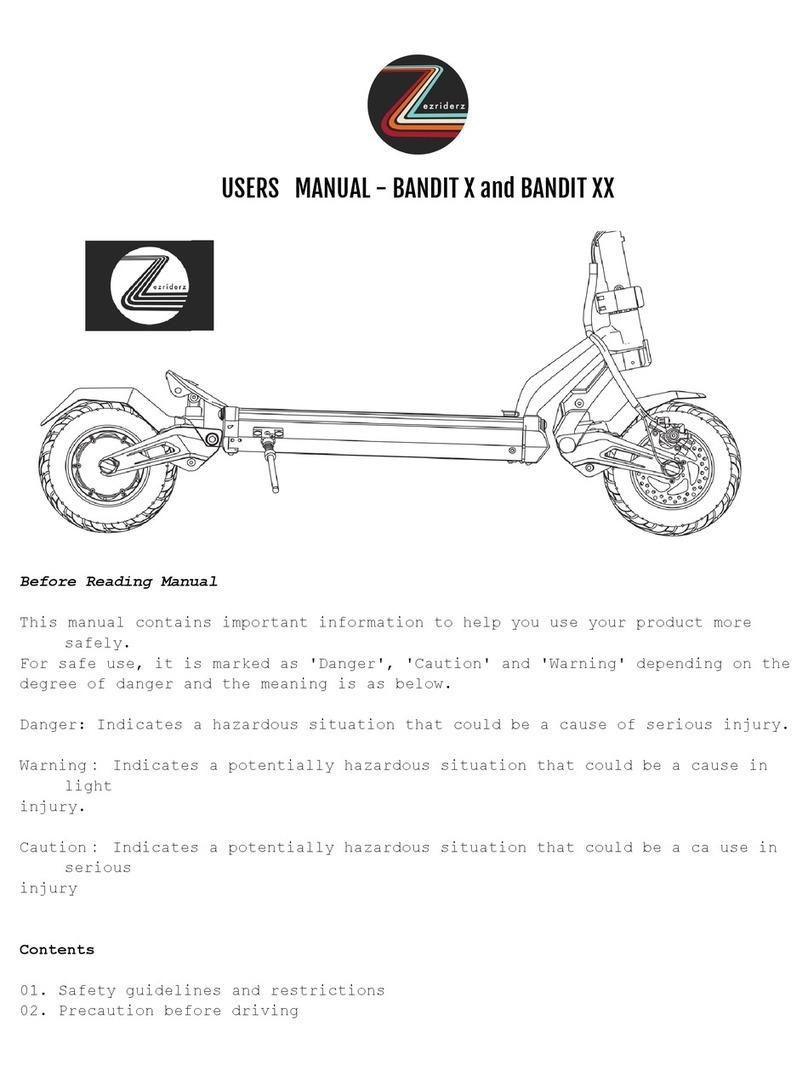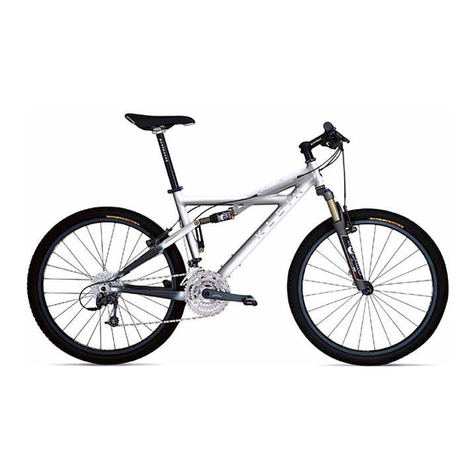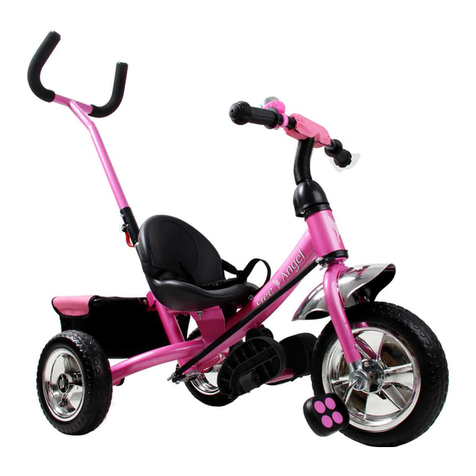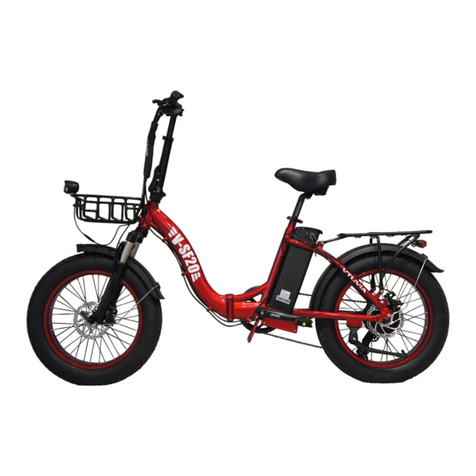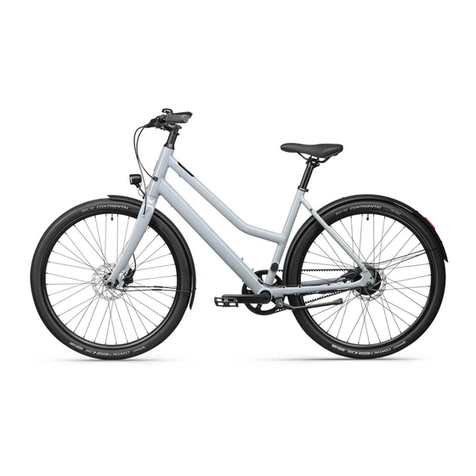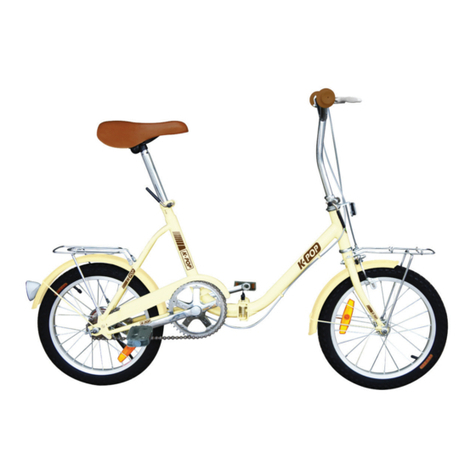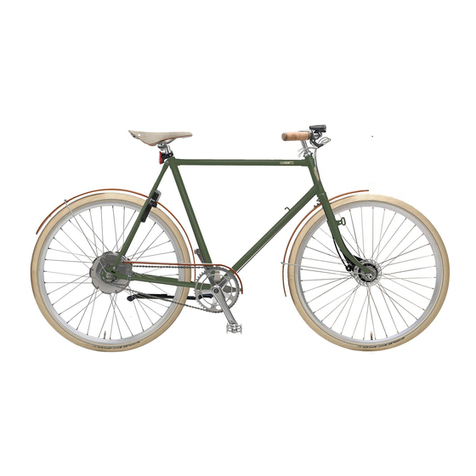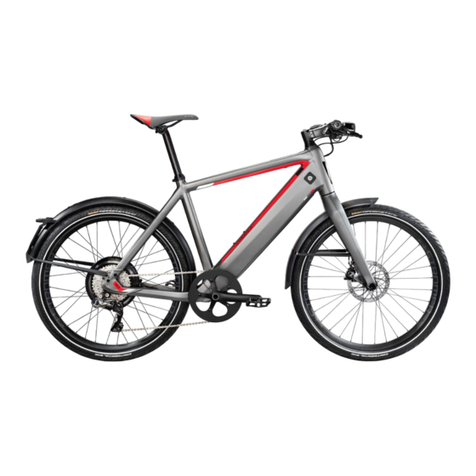BMX K2 User manual

BICYCLE
OWNERS
MANUAL

Serial Number:
Model Name:
Model Year:
Store Purchased From:
Purchase Date:
IMPORTANT: ATTACH THE BICYCLE SALES RECEIPT
BICYCLE OWNERS MANUAL
Before proceeding through the rest of this manual we urge you to locate your bicycle serial number
which is permanently stamped on the frame. Record the number in this manual in the event your
bicycle is stolen. It will also come in handy if required for possible bicycle registration or licensing.

CORRECT FITTING - MAKE
SURE YOUR HELMET COVERS
YOUR FOREHEAD.
INCORRECT FITTING. FOREHEAD
IS EXPOSED AND VULNERABLE
TO SERIOUS INJURY.
ALWAYS WEAR A PROPERLY
FITTED HELMET WHEN
YOU RIDE YOUR BICYCLE.
DO NOT RIDE AT NIGHT.
AVOID RIDING IN WET
CONDITIONS.
HELMETS
SAVE
LIVES !!! X
I

DIRECTORY
Parts Identification ...........................................................2-4
Before You Ride..............................................................5-15
Lubrication Schedule........................................................74
Basic Maintenance, Storage and Security.................59-73
Purchase Record and Warranty.......................................78
Warning / Important
Take notice of this symbol throughout this manual and pay particular
attention to the instructions blocked off and preceded by this symbol.
Troubleshooting ...........................................................75-77
III
Bike Assembly ..............................................................16-54
How To Operate ............................................................55-58
?

01
1. PARTS IDENTIFICATION 2-4
Mountain Bicycles 2
BMX Bicycles 3
Tools Required 4
2. BEFORE YOU RIDE 5-17
Correct Frame Size 5
Riding Position 6
-Saddle Height 6
-Reach 6
-Handlebar Height 7
Safety Checklist 8-11
-Brakes 8
-Wheels & Tires 8
-Steering 8
-Chain 9
-Bearings 9
-Cranks & Pedals 9
-Derailleurs 9
-Frame & Fork 9
-Accessories 9
Helmets 10
Reflectors 11
Torque Requirements 11
Riding Safely 12-14
General Rules 12
-Wet Weather Riding 13
-Night Riding 13
-Pedaling Technique 13
-Hill Technique 14
-Cornering Technique 14
-Rules for Children 14
Bike Assembly 15-54
Derailleur Geared Bikes 15-37
-Getting Started 15
-Handlebars 15-17
-Shifters 18
-Forks 19
-Seat & Seat Post 20
-Pedals & Crank Set 21
-Front Wheel 22
-Front Brake 23
-Cantilever Brakes 23-25
-V-Style Brakes 25-27
-Disc Brakes 28-29
-Rear Derailleur 30
-Front Derailleur 31
-Dual Suspension 32
-Rear Pivot 33
-Reflectors 34
-Fenders 35-36
-Final Check 37
Single Speed & BMX Bikes 38-54
-Getting Started 38
-Handlebars 38
-Seat 39
-Pedals & Crank Set 39
-Front Wheel 40
-Front Brake 40
-Side Pull Brakes 41
-Cantilever Brakes 41-43
-V-Style Brakes 44-45
-U-Brakes 46
-Brake Lever 47
-Coaster Brakes 47
-Check Your Brakes 47-49
-Axle Peg Assembly 50
-Training Wheels 51-53
-Final Check 54
How to Operate 55-57
-Derailleur Gears 55
-Operating Principles 55
-Hand Grip Shifters 56
-Thumb Shifters 57
-Below the Bar Shifters 57
-Check Your Brakes 58
BASIC MAINTENANCE,
STORAGE & SECURITY 59-73
-Maintenance and Lubrication 59
Wheels and Tires 60-62
-Wheel Inspection 60
-Tire Inspection 61
-Recommended Tire Pressures 61
-Hub Bearing Adjustment 62
Handlebars and Stem 63-65
-Handlebar Stem 63-64
-Handlebars 64
-Cables & Cable Housing 65
Saddle & Seat Post 66-67
-Inspection 66
-Lubrication 66
-Adjustment 67
Brakes 68-71
-Inspection 68
-Lubrication 69
-Adjustment Sidepull Calipers 69-70
-Adjustment Cantilever Calipers 70-71
-Coaster Brakes 71
Quick Release Levers 72
Reflectors 72
Storage 73
Security 73
LUBRICATION SCHEDULE 74
TROUBLESHOOTING 75-77
PURCHASE RECORD
& WARRANTY 78

02
Gear Control
Cable
Rear Derailleur
PARTS IDENTIFICATION
Mountain Bicycles . Mountain bicycles are designed to give maximum comfort over a wide variety of road surfaces. The
wider handlebars and convenient shift lever position make them very easy to control. Wider rims and tires give them a softer
ride with more traction on rough surfaces. The frame and fork on mountain style bicycles are generally much sturdier than those on
racing style bicycles.
Top Tube
Seat
Seat Post
Quick Release
Seat Stay
Rear Reflector
Rear Brake
Wheel Reflector
Freewheel
Shift Lever
Handlebar
Brake Lever
Brake Control Cables
Front Reflector
Front Brake
Front Fork
Wheel Reflector
Front Wheel Hub
Spokes
Handlebar Stem
Head Set
Head Tube
Seat Tube
Down Tube
Gear Control Cable
Front Derailleur
Bottom
Bracket Axle
Rim
Tire
Chain Wheel
Crank Arm
Pedal
Chain Stay
Chain
Tire Valve

03
BMX Bicycles . BMX style bicycles are a popular general purpose type most suited for young riders. They are
valued because of their sturdy and simple construction, and low maintenance.
Seat
Seat Post
Seat Post Binder Bolt or
Quick-Release Skewer
Seat Stay
Rear Reflector
Wheel Reflector
Chain Wheel
Crank Arm
Pedal
Rim
Tire
Tire Valve
Chain
Chain Stay
Rear Sprocket
Training Wheel
Front Brake Lever
Handlebar
Brake Control Cable
Front Reflector
Front Brake
Brake Pad
Front Fork
Wheel Reflector
Front Wheel Hub
Spokes
Handlebar Grip
Handlebar Stem
Head Set
Head Tube
Top Tube
Seat Tube
Down Tube

04
The following instructions will enable you to prepare your bicycle for years of enjoyable cycling. For more
details on inspection, lubrication, maintenance and adjustment of any area please refer to the relevant sections
in this manual. You will save time and the inconvenience of having to go back to the store if you choose to write
or call us concerning missing parts, service questions or operating advice at:
SERVICE AND TECHNICAL SUPPORT:
1-631-780-5360
Tools Required:
•Phillips head screw driver
•4mm, 5mm 6mm & 8mm Allen keys
•Adjustable wrench or a 9mm, 10mm,
14mm & 15mm open and box end wrenches
•A pair of pliers with cable cutting ability
To avoid injury, this product must be properly assembled before use. If your bicycle was
obtained assembled, we strongly recommend that you review the complete assembly
instructions and perform checks specified in this manual before riding.

05
CORRECT FRAME SIZE
When selecting a new bicycle, the correct choice of frame size is a very important safety consideration. Most full sized
bicycles come in a range of frame sizes. These sizes usually refer to the distance between the center of the bottom bracket
and the top of the frame seat tube.
For safe and comfortable riding there should be clearance of no less than 1 - 2 inches between
the groin area of the intended rider and the top tube of the bicycle frame, while the rider straddles the
bicycle with both feet flat on the ground.
The ideal clearance will vary between types of bicycles and rider preference. This makes straddling the frame when off the
saddle easier and safer in situations such as sudden traffic stops. Women can use a men’s style bicycle to determine the
correct size women’s model.
The following chart and diagram will help you make the correct choice. Rider leg length refers to approximate pant inseam.
BEFORE YOU RIDE
Approximate Rider Leg
Length
61-69cm / 24-27 inches
66-76cm / 26-30 inches
71-79cm / 28-31 inches
76-84cm / 30-33 inches
79-86cm / 31-34 inches
81-89cm / 32-35 Inches
86-94cm / 34-37 inches
Suggested Frame Size for
Racing/Touring Bicycle
-
-
50cm / 19.5 inches
55cm / 21.5 inches
57cm / 22.5 inches
60cm / 23.5 Inches
63cm / 25 inches
Suggested Frame Size for
Mountain or Hybrid Bicycle
37cm / 14.5 inches
43cm / 17 inches
45cm / 18 inches
50cm / 19.5 inches
52cm / 20.5 inches
53-56cm / 21-22 Inches
58-60cm / 23-23.5 inches
Frame Sizing Guide
1-2in.

06
RIDING POSITION
Saddle Height
In order to obtain the most comfortable riding position and offer the
best possible pedaling efficiency, the seat height should be set
correctly in relation to the rider’s leg length. The correct saddle height
should not allow leg strain from over-extension, and the hips should
not rock from side to side when pedaling. While sitting on the bicycle
with one pedal at its lowest point, place the ball of your foot on that
pedal. The correct saddle height will allow the knee to be slightly
bent in this position. If the rider then places the heel of that foot on
the pedal, the leg should be almost straight.
Under no circumstances should the seat post project
from the frame beyond its “Minimum Insertion” or
“Maximum Extension” mark. If your seat post projects
from the frame beyond these markings, the seat post
or frame may break, which could cause you to lose
control and fall. Prior to your first ride, be sure to tighten the
saddle adjusting mechanism properly. A loose saddle clamp or
seat post binder can cause damage to the bicycle or can cause
you to lose control and fall. Periodically check to make sure that
the saddle adjusting mechanism is properly tightened.
Reach
To obtain maximum comfort, the rider should not overextend his or her
reach when riding.
To adjust this distance, the position of the seat can be altered in
relation to the seat pillar.
Maximum Height /
Minimum Insertion Mark
(Should not be visible)
Arms not over-
extended
Handlebar stem
height about the
same as
seat height
Pedal at
bottom position

07
Handlebar Height
Maximum comfort is usually obtained when the handlebar height is
equal to the height of the seat. You may wish to try different heights
to find the most comfortable position.
Threadless headsets and clamp-on stems are not adjustable.
The stem’s “Minimum Insertion” mark must not be visible above the top of the headset.
If the stem is extended beyond this mark, the stem may break or damage the fork’s
steerer tube, which could cause you to lose control and fall.
Failure to properly tighten the stem binder bolt, the handlebar binder bolt, or the bar
end extension clamping bolts may compromise steering action, which could cause
you to lose control and fall. Place the front wheel of the bicycle between your legs and
attempt to twist the handlebar/stem assembly using a reasonable amount of force. If
you can twist the stem in relation to the front wheel, turn the handlebars in relation to
the stem, or turn the bar end extensions in relation to the handlebar, you must tighten
the appropriate bolts accordingly.
Stem Wedge Bolt
Maximum Height/
Minimum Insertion
Mark
Handlebar Binder Bolt
Exceeds 2 1/2”
(64mm)

08
SAFETY CHECKLIST
Before every ride, it is important to carry out the following safety checks:
1. Brakes
- Ensure front and rear brakes work properly.
- Ensure brake shoe pads are not over worn and are correctly positioned in relation to the rims.
- Ensure brake control cables are lubricated, correctly adjusted and display no obvious wear.
- Ensure brake control levers are lubricated and tightly secured to the handlebar.
2. Wheels and Tires
- Ensure tires are inflated to within the recommended limit as displayed on the tire sidewall.
- Ensure tires have tread and have no bulges or excessive wear.
- Ensure rims run true and have no obvious wobbles or kinks.
- Ensure all wheel spokes are tight and not broken.
- Check that axle nuts are tight. If your bicycle is fitted with quick release axles, make sure locking levers
are correctly tensioned and in the closed position.
3. Steering
- Ensure handlebar and stem are correctly adjusted and tightened, and allow proper steering.
- Ensure that the handlebars are set correctly in relation to the forks and the direction of travel.
- Check that the headset locking mechanism is properly adjusted and tightened.
- If the bicycle is fitted with handlebar end extensions, ensure they are properly positioned and tightened.

09
4. Chain
- Ensure chain is oiled, clean and runs smoothly.
- Extra care is required in wet or dusty conditions.
5. Bearings
- Ensure all bearings are lubricated, run freely and display no excess movement, grinding or rattling.
- Check headset, wheel bearings, pedal bearings and bottom bracket bearings.
6. Cranks and Pedals
- Ensure pedals are securely tightened to the cranks.
- Ensure cranks are securely tightened to the axle and are not bent.
7. Derailleurs
- Check that front and rear mechanisms are adjusted and function properly.
- Ensure control levers are securely attached.
- Ensure derailleurs, shift levers and control cables are properly lubricated.
8. Frame and Fork
- Check that the frame and fork are not bent or broken.
- If either are bent or broken, they should be replaced.
9. Accessories
- Ensure that all reflectors are properly fitted and not obscured.
- Ensure all other fittings on the bike are properly and securely fastened, and functioning.
- Ensure the rider is wearing a helmet.

10
Helmets
It is strongly advised that a properly fitting, ANSI or SNELL, or CSA
certified, bicycle safety helmet be worn at all times when riding your
bicycle. In addition, if you are carrying a passenger in a child safety
seat, they must also be wearing a helmet.
The correct helmet should:
- be comfortable
- be lightweight
- have good ventilation
- fit correctly
- cover forehead
Always wear a properly fitted helmet which covers the forehead when riding a bicycle. Many provinces
require specific safety devices. It is your responsibility to familiarize yourself with the laws of the province
where you ride and to comply with all applicable laws, including properly equipping yourself and your bike
as the law requires.

11
Reflectors
Your bicycle is supplied with one front (white), one rear (red), two wheel (white), and four pedal (orange)
reflectors. (Please Note: Sidewalk bikes, 12” and under, may not have reflectors.) These are an important safety and legal
requirement, and should remain securely fitted and in good, clean condition at all times. Periodically, inspect all reflectors,
brackets and mounting hardware for signs of wear or damage. Replace immediately if damage is found.
Torque Requirements
Newton Meters
1. Front wheel axle nuts 27– 35
2. Rear wheel axle nuts 27 – 35
3. Handlebar clamp nut/bolt 17 – 19
4. Handlebar stem bolt 17 – 19
5. Seat pillar clamp/nut/bolt 15 – 19
6. Brake mounting nut/bolt 8 – 12
7. Brake cable anchor nut 5 – 8
8. Seat clamp nut 16 – 23
9. Cotterless crank nut 27 – 28.5
10. Pedal 23 – 27
For safe cycling we recommend that a torque (tension) wrench be used to tighten critical parts to the correct tension.

12
RIDING SAFELY
General Rules
When riding obey the same road laws as all other road vehicles, including giving way to
pedestrians, and stopping at red lights and stop signs.
For further information, contact the Road Traffic Authority in your province.
Ride predictably and in a straight line. Never ride against traffic.
Use correct hand signals to indicate turning or stopping.
Ride defensively. To other road users, you may be hard to see.
Concentrate on the path ahead. Avoid pot holes, gravel, wet road markings, oil, curbs, speed
bumps, drain grates and other obstacles.
Cross train tracks at a 90 degree angle or walk your bicycle across.
Expect the unexpected such as opening car doors or cars backing out of concealed driveways.
Be extra careful at intersections and when preparing to pass other vehicles.
Familiarize yourself with all the bicycle's features. Practice gear shifts, braking, and the use of
toe clips and straps, if fitted.
If you are wearing loose pants, use leg clips or elastic bands to prevent them from being caught
in the chain. Wear proper riding attire and avoid open toe shoes.
Don't carry packages or passengers that will interfere with your visibility or control of the bicycle.
Don't use items that may restrict your hearing.
Do not lock up the brakes. When braking, always apply the rear brake first, then the front. The
front brake is more powerful and if it is not correctly applied, you may lose control and fall.
Maintain a comfortable stopping distance from all other riders, vehicles and objects.
Safe braking distances and forces are subject to the prevailing weather conditions.

13
Wet Weather
IT IS RECOMMENDED TO NOT RIDE IN WET WEATHER
- In wet weather you need to take extra care.
- Brake earlier, you will take a longer distance to stop.
- Decrease your riding speed, avoid sudden braking and take corners with additional
caution.
- Be more visible on the road.
- Wear reflective clothing and use safety lights.
- Pot holes and slippery surfaces such as line markings and train tracks all become more
hazardous when wet.
Night Riding
- Ensure bicycle is equipped with a full set of correctly positioned and clean reflectors.
- Use a properly functioning lighting set comprising of a white front lamp and a red rear lamp.
- If using battery powered lights, make sure batteries are well charged.
- Some rear lights available have a flashing mechanism which enhances visibility.
- Wear reflective and light colored clothing.
- Ride at night only if necessary. Slow down and use familiar roads with street lighting, if possible.
Pedaling Technique
- Position the ball of your foot on the center of the pedal.
- When pedaling, ensure your knees are parallel to the bicycle frame.
- To absorb shock, keep your elbows slightly bent.
- Learn to operate the gears properly.
IT IS RECOMMENDED TO NOT RIDE AT NIGHT

14
Hill Technique
- Gear down before a climb and continue gearing down as required to maintain pedaling speed.
- If you reach the lowest gear and are struggling, stand up on your pedals. You will then obtain more power from
each pedal revolution.
- On the descent, use the high gears to avoid rapid pedaling.
- Do not exceed a comfortable speed; maintain control and take additional care.
Cornering Technique
Brake slightly before cornering and prepare to lean your body into the corner. Maintain the inside pedal at the 12 o'clock
position and slightly point the inside knee in the direction you are turning. Keep the other leg straight, don't pedal through
fast or tight corners.
Rules for Children
To avoid accidents, teach children good riding skills with an emphasis on safety from an early age. Children should be super-
vised by an adult.
1. Always wear a properly fitted helmet.
2. Do not play in driveways or the road.
3. Do not ride on busy streets.
4. Do not ride at night.
5. Obey all the traffic laws, especially stop signs and red lights.
6. Be aware of other road vehicles behind and nearby.
7. Before entering a street: Stop, look right, left, and right again for traffic. If there's no traffic, proceed into the roadway.
8. If riding downhill, be extra careful. Slow down using the brakes and maintain control of the steering.
9. Never take your hands off the handlebars, or your feet off the pedals when riding downhill.

15
DERAILLEUR GEARED BICYCLES
Includes 20", 24” and 26" Wheel Mountain Bikes
Assembly is the same for men’s
and women’s bikes.
Getting Started
Open the carton from the top and remove the bicycle. Remove the
straps and protective wrapping from the bicycle. Inspect the bicycle
and all accessories and parts for possible shortages. It is recommended
that the threads and all moving parts in the parts package be lubricated
prior to installation. Do not discard packing materials until assembly is
complete to insure that no required parts are accidentally discarded.
Assemble your bicycle following the steps that pertain to your model.
Note: Your bicycle may be equipped with different style components
than the ones illustrated.
Handlebars
Remove the protective cap from the handlebar stem wedge and loosen
the Allen key bolt using the 6mm Allen key. Some models may use a
13mm hexagonal bolt instead of an Allen key bolt. Place the handlebar
stem into the top of the head tube, ensuring that all cables are free of
tangles. Tighten the stem bolt observing the minimum insertion mark and
checking that the forks and the handlebars are facing forward. Check
the headset for smooth rotation and that the top nut is secured tightly.
Loosen the 6mm Binder Bolt and rotate the handlebar forward so the
levers are at a 45 degree angle below the handlebar. Retighten the
Binder Bolt to ensure the handlebar does not rotate in the stem.
Minimum Insertion
Mark
Stem Bolt
Head Tube
Binder Bolt
Top Nut
BICYCLE ASSEMBLY
Wedge
Warning: Over tightening the stem bolt or headset
assembly may cause damage to the bicycle and/or
injury to the rider.
We recommend that you consult a bicycle specialist
if you have doubts or concerns as to your experi-
ence or ability to properly assembly, repair, or main-
tain your bicycle.

16
NOTE: Comfort Series (CS) bicycles may be equipped with a stem that has an adjustable angle.
In addition to the normal assembly, these stems will require angling the stem to the desired position,
and securely tightening the 6mm angle bolt located in front of the stem bolt.
Failure to do this may cause loss of steering control.
Tightening/Preloading Aheadset
Stem Installation (Should be assembled on the
bike already)
1. Insert the compression bolt through the top
cap and the stem. Begin threading into the
star nut.
2.Tighten compression bolt so it removes all
play from the fork, but allows the fork to rotate
smoothly.
3. Align the stem with the front wheel. Tighten
the stem clamp bolts to secure the stem to the
steerer tube.
Handlebar Installation
1. Remove the stem cap bolts and stem cap.
2. Insert handlebar into the stem cap.
3. Tighten the stem cap bolts equally. Note
the distance between the stem and stem cap:
It should be equal on the top and bottom of the
stem cap. Amust be equal distance.
Installed
by
factory
Compression Bolt
Top Cap
Stem Clamp Bolts
Spacer
Headset Wedge
Bearing Race
Bearing Dust Cover
Bearing Retainer
Star Nut
(Inside Steerer Tube)
Upper Headset Cup
Headtube
Lower Headset Cup
Bearing Retainer
Bearing Dust Cover
Headset Crown Race
fork
Steerer Tube
Handlebar
Stem Cap
Bolts
Stem Cap
Table of contents
